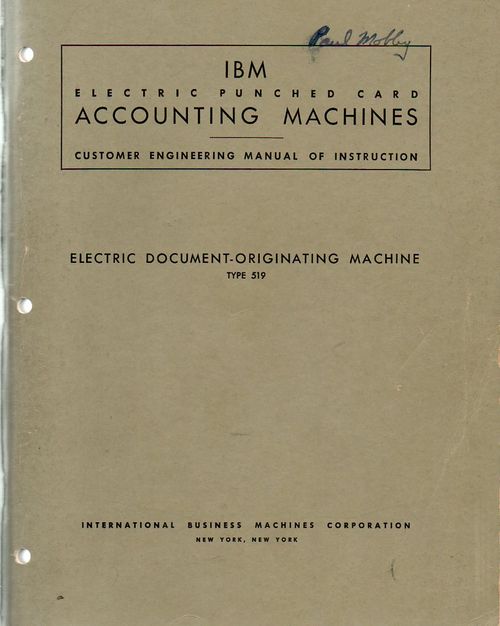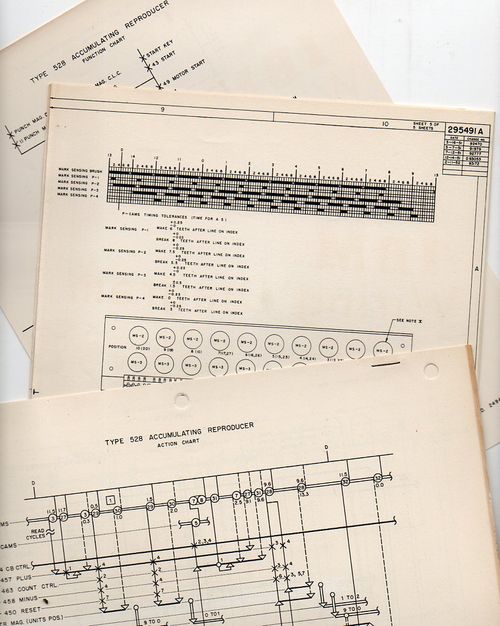JF Ptak Science Books Post 1379
"Gang punches, summary punches and reproducing punches....such are the guts and glory of all good punch dreams"--No one, ca. 1957.
 This story has to do more with Jacquard than with Marciano. One of the mainstays of the pre-computer computer room, the ubiquitous instrument as prevalent then as the desktop is now, was the unit record machine, which operated with punched cards for program entry and data storage. This machine--like the IBM Type 5191 Electric Document-Originating Machine (1952) described below--functioned to read and reproduce the mainstay of the calculating instrument of the 1930's to the early 1950's.
This story has to do more with Jacquard than with Marciano. One of the mainstays of the pre-computer computer room, the ubiquitous instrument as prevalent then as the desktop is now, was the unit record machine, which operated with punched cards for program entry and data storage. This machine--like the IBM Type 5191 Electric Document-Originating Machine (1952) described below--functioned to read and reproduce the mainstay of the calculating instrument of the 1930's to the early 1950's.
Their functions included lots of punching: gang punch, which would produce a large number of identically punched card; reproducing punch, which "could reproduce a deck of cards in its entirety or they might just reproduce selected fields...a payroll master deck might be reproduced at the end of a pay period with the hours worked and net pay fields blank and ready for the next pay period's data. Computer programmers who created their programs in the form of punched card decks used these to make backups"; a summary punch, which were attached to tabulating machines and could punch new cards with details and totals from the tabulating machine; and the mark sense reader, "which could detect pencil marks on ovals printed on the card and punch the corresponding data values into the card".
The IBM 519 was one such punching machine, sitting in command of vast legions of data that had previously been exceptional if not impossible to corral. Improvements like this, these sorts of technological breakthroughs, allowed for the nervous system of the second industrial revolution to occur. Of course one needed electricity, and then the machines that would be powered by them, and then the distribution capacities to get the electricity to the millions of end-users who would in turn purchase the new electrical goods--all of this was necessary. However, without the ability to get this electricity paid for by it subscribers, without the power company being able to collect revenue, this stuff doesn't happen. And the way that the power company collects is by sending out an ocean of bills, which means that the ocean needed to be controlled in some way, all of the data handled and audited, which means that there was a new, mechanical way of dealing with the vast transfer of data. And that's where machines such as the Grunts and Gruffs come in. Like the 519. 
(These IBM manuals are available for sale at our blog bookstore, here.)
This thought bubbled to the top while I was looking through a user's manual for the 519, an updated 1952 version of the first edition of 1943. It is a beautiful work, filled with all of the information that a user would need to operate the machine as well as the specs necessary for the engineer to maintain the thing. It was bound in a heavy, plasticized flexible cover, intended for wear and tear, and also came with an additional six pamphlets ,mostly wiring diagrams, one of which--the wiring diagram for the 519--unfold its 11 inch height out to five feet in length, a gorgeous panorama of organized and directed electricity. It has two mates,a pair not quite as long--four feet or so--in the wiring diagram for the 519's reproducing punch, lovely things in and of themselves.
The documents just have a satisfying feel ot them, manuals for maintenance and repair for machines that could be maintained and repair. IF they were still needed, I'm sure that they would be running today.
Notes:
1. "Early computer installations used punched cards for program entry and storage. A typical corporate or university computer lab would have a room full of keypunch machines for programmer use. An IBM 407 Accounting Machine might be set up to allow newly created or edited programs to be listed (printed out on fan-fold paper) for proof reading. An IBM 519 might be provided to reproduce program decks for backup. The 519 could also punch sequential numbers in columns 73-80 of COBOL or Fortran program decks. Those languages and others did not use those columns; the use of only 72 columns is a convention tracing back to the IBM 704 computer's card reader, the 711, which could only read 72 columns (selectable by a plug-wired control panel). An IBM 80 series sorter would be used to put things back in order if a sequenced deck was dropped. A quicker, but less effective, protection against dropped card decks was drawing a diagonal line across the top of the deck with a marking pen."--from Wiki on the IBM 519."
And from WorldLingo comes this:
"The IBM 519 Electric Document Originating Machine, introduced in 1946, was the last in a series of unit record machines designed for automated production of punch cards. It could reproduce all or parts of the information on a set of cards; copy the information from a master card onto a group of detail cards; printing up to eight digits on the end of the card; compare two decks of cards, punch summary information provided by an accounting machine. It could operate at 100 cards per minute."
"Optional features allowed the 519 to read pencil marks on cards and punch the data they contain, and to number cards consecutively. The 519 was programmed by wiring a removable control panel. IBM called the operation of converting cards marked with pencil marks into punched cards “mark sensing.” Mark sensing allowed a person to enter data to be used in punched-card data processing without using a key punch machine. It was used for tasks like recording long distance calls and meter readings. Unlike other types of IBM unit record equipment, the 519 fed cards face down 12 edge first. The advantage of this was worn out decks from other equipment (which fed cards face down 9 edge first), having frayed 9 edges would still feed reliably through the reproducer, allowing a fresh copy to be made."
2. The Electric Document-Originating Machine Type 519, IBM Electric Punched Cards Accounting Machine, Customer Engineering Manual of Instruction. IBM, NYC: 1952. 1x8 inches, 124pp, illustrated.



Comments